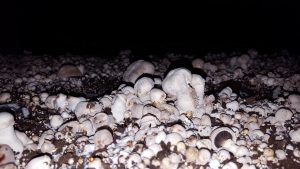Unintended Consequences
Being a business owner provides me with the opportunity to make what feels like a thousand decisions per day. Sometimes it can be overwhelming with the sheer number of choices I have to consider. It can be mentally exhausting. When considering a decision to be made, one of the first places my mind goes is considering the “consequences.” Have you ever made a decision that led to an outcome you weren’t expecting?
Growing Decision
Last year, we worked on solutions to help with the disease that we struggle with within the mushroom crops. It’s called verticillium or bubble. If the bubble is left unchecked, it can take over a crop and hurt productivity. One of our friends at another mushroom farm suggests we change a part of our compost recipe. More specifically, the dried poultry waste or DPW. He told us to use a synthetic nitrogen source like urea to see if the DPW was the source of our bubble problem.

So, we decided to try a crop using urea instead of DPW. The crop looked different during composting and behaved differently in the spawning process as well. It was not as well-composted, and we struggled to get enough dry weight into the trays. In the mushroom industry, dry weight correlates closely with the yield of the crop. I remember our Agriculture Manager, who oversees our growing operations, was concerned about how this crop was behaving and prepped me for the possibility of a low-yielding crop.
That Was Unexpected
We were all pleasantly surprised when the crop performed very well, as far as productivity. We were disappointed to see that it did not affect the bubble problem. However, the increased production of lower dry weights led us to research what happened with the crop. It came down to the ash content of the compost. Ash content measures the inorganic matter, like dirt and rocks; the mushrooms can not use that. We found this crop to have a very low ash content compared to the surrounding crops. For years, we ran our ash contents around 40-50%, which means that 50-60% of the compost was available to the mushrooms for food. The urea crop was in the 30%s. After more digging, we found that our source for DPW was supplying us with more dirt and feathers than poultry waste. We continued with some more trials with urea and other sources of DPW and found the same results.

Acting on what we learned has led to a dramatic increase in our yields. Our yields have increased by over 25%, and we’ve had to reduce the number of trays we use in the rooms because we were over producing for our market demand. Again, another unintended consequence.